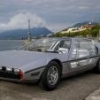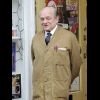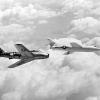
Peter Twiss RIP
#1

Posted 02 September 2011 - 05:29
A very good piece on last night's South Today on the BBC with excellent archive film of the record attempt flying from Boscombe Down.
Another link with the past gone but definitely not forgotten.
Advertisement
#2

Posted 02 September 2011 - 06:30
Many people will be saddened by the death yesterday (Thursday) of Peter Twiss at the age of 90. He was the last British holder of the world's air speed record set at 1,132mph in 1956 in the Fairey FD.2 - the last occasion that Britain held the world records in the air, on water and on land concurrently. John Cobb's land speed record of 394mph (including the first one-way run at over 400mph) was set in 1947 with the Railton Mobil Special and was not to be broken until 1964 and Donald Campbell had already established several water speed records with Bluebird K7.
A very good piece on last night's South Today on the BBC with excellent archive film of the record attempt flying from Boscombe Down.
Another link with the past gone but definitely not forgotten.
I've just been reading "Empire in the Clouds", a paen to the British aircraft industry, which features men like Twiss, John Derry and Neville Duke, who would climb into experimental aircraft and push them to their limit even while the remains of the last unsuccesful attempt lay smoking on the runway. These gentlemen must have had specially fitted flight suits to accommodate certain parts of their anatomy.
#3

Posted 02 September 2011 - 06:48
#4

Posted 02 September 2011 - 08:24
RIP Peter - one of my childhood heroes.
Me too, I made a Jetex powered model of his Fairey Delta 2. It didn't fly very well, I made it far too heavy with lovingly applied silver paint.
#5

Posted 02 September 2011 - 08:37
"Empire in the Clouds" seems to concentrate of the GeeWhizz test pilot image, but those I knew who had been active in the 1950s were far from the gung-ho image that the cheap newspapers promoted. I never met Twiss or Lithgow (different companies) but did know some of the de Havilland and Hawker pilots of the '60s and '70s (and former Airspeed CTP George Errington).
#6

Posted 02 September 2011 - 08:50
Me too, I made a Jetex powered model of his Fairey Delta 2. It didn't fly very well, I made it far too heavy with lovingly applied silver paint.
I quite vividly remember, aged about six, making a cut-out card model of the FD.2 - so probably about three years after the record - we were given whilst at school. Whatever would health & safety say about that now?!
#7

Posted 02 September 2011 - 08:58
It was a very different world in "his day" - Twiss got his record at altitude along the south coast of England, whereas until a couple of years before sea level (or thereabouts) was used, so the previous British holder of the Air Speed Record, Mike Lithgow in a Supermarine Swift, had flown it in Libya where nobody minded a 735.7 m.p.h. aeroplane close to the ground.
Mike Lithgow is one of the "forgotten heroes" too. I always thought that the Supermarine Swift - as a kind of stop-gap prior to the introduction of teh Hawker Hunter - was not only a good looking aircraft but also a reasonably successful one. As one who believes that past achievements such as this do need commemorating it is sad that Lithgow's Swift (WK198) only survives as a stripped fuselage. Having originally been rescued, and partially conserved, in the early 1980s by the North-East Aircraft Museum, and subsequently loaned to the now defunct Millom Aircraft Museum, this Swift is currently at Brooklands. It is still apparently owned by the scrapyard at Failsworth in Manchester in which it languished prior to being "rescued".
Edited by Pullman99, 02 September 2011 - 10:46.
#8

Posted 02 September 2011 - 09:13
The DH110 comes to mind but perhaps I am confusing his name with that sad incident.
PT worked in one of the most exciting times for the British aero industry and I wonder if he was dismayed at the sad decline of so many of the great names.
RIP.
Richard
PS - I never seem to have got my Jetex powered planes to fly at all!
#9

Posted 02 September 2011 - 10:08
PS - I never seem to have got my Jetex powered planes to fly at all!
The larger units were a bit better, but the small ones I had gave very modest power for not a long time, the secret to getting them to work well was cleanliness and packing the pellets and fuses correctly. Planes had to be kept very lightweight indeed to perform, but the 'add lightness' mentality must have made an impression,on me, it could have been what attracted me to work at Lotus some years later.
#10

Posted 02 September 2011 - 10:37
I thought the Swift and the Hunter were both targeted at the same target. The Swift was faster as it took the Hunter's record, but I think it had aerodynamic problems associated with the air intakes, eg firing the guns made the flow unstable. So the Hunter became the RAF's main fighter until the Lightning took over and found a ready market around the world.Mike Lithgow is one of the "forgotten heroes" too. I always thought that the Supermarine Swift - as a kind of stop-gap prior to the introduction of teh Hawker Hunter - was not only a good looking aircraft but also a reasonably successful one. As one who believes that past achievements such as this do need commemorating it is sad that Lithgow's Swift (WK198) only survives as a stripped fuselage. Having originally been rescued, and partially conserved, in the early 1980s by the North-East Aircraft Museum, and subsequently loaned to the now defunct Millom Aircraft Museum, this Swift is currently at Brooklands. It is still apparently owned by the scrapyard at Failsworth in Manchestyer in which it languished prior to being "rescued".
#11

Posted 02 September 2011 - 11:04
Continuing this bit of thread drift, Duncan is right in that both Supermarine and Hawker developed them from their earlier jet fighters at the same time for the same reason. Both started with RR Nene engined aeroplanes to spec. 10/44, Supermarine from Attacker, via the 510 and 535 to Avon-powered Swift and Hawker from Sea Hawk via P1052 and P1081 to Avon-powered P1067 Hunter.I thought the Swift and the Hunter were both targeted at the same target. The Swift was faster as it took the Hunter's record, but I think it had aerodynamic problems associated with the air intakes, eg firing the guns made the flow unstable. So the Hunter became the RAF's main fighter until the Lightning took over and found a ready market around the world.
Meanwhile we at de Havilland developed the DH100 Vampire (DH Goblin) into the Venom (Ghost) and DH108 from the swept-wing aerodynamics of which the twin-Avon DH110 was evolved and from it the Sea Vixen - by which time we were fully committed to civil aeroplanes and apart from a STOL transport submission, never did anything military again. Hence I'm a bit hazy about the sequence of other companies' fighters. . .
#12

Posted 02 September 2011 - 11:04
The larger units were a bit better, but the small ones I had gave very modest power for not a long time, the secret to getting them to work well was cleanliness and packing the pellets and fuses correctly. Planes had to be kept very lightweight indeed to perform, but the 'add lightness' mentality must have made an impression,on me, it could have been what attracted me to work at Lotus some years later.
Just remember the burnt fingers from trying to extract the charred fuse from the exhaust hole, from which it was meant to be expelled by the mighty thrust but seldom was. I expect I wa doing it all wrong ...
#13

Posted 02 September 2011 - 11:22
#14

Posted 02 September 2011 - 11:56
#15

Posted 02 September 2011 - 14:36
My father worked for Plessey - famous for Plessey aero pumps and used in various auto applications as well...eg injected Alfa racing engines - 3/4 years in the fifties I went to the Farnborough airshow with him and well remember demo flights by Peter Twiss.
The DH110 comes to mind but perhaps I am confusing his name with that sad incident.
PT worked in one of the most exciting times for the British aero industry and I wonder if he was dismayed at the sad decline of so many of the great names.
RIP.
Richard
PS - I never seem to have got my Jetex powered planes to fly at all!
The DH 110 was flown by John Derry.
#16

Posted 02 September 2011 - 14:58
One flight, crash and burn.
Edited by Rob Miller, 02 September 2011 - 14:59.
#17

Posted 02 September 2011 - 15:12
And my late father was at Farnborough Airshow in September 1952 when John Derry was killed when the prototype DH110 broke up. There were 31 ground fatalities and many injured by one of its twin engines landing amongst the crowd right where my father had been standing a few minutes beforehand. A tragedy of similar proportions to Le Mans 1955, it is interesting to note the crash only caused a short delay in the airshow, which resumed with Neville Duke flying the Hunter in a supersonic dive to a hushed silence from the crowd still in shock from Derry's tragic accident.The DH 110 was flown by John Derry.
Marticelli
#18

Posted 02 September 2011 - 16:57
My father too was at Farnborough in 1952 as part of the team from Hawkers. I subsequently went with him a number of times. He introduced me to Neville Duke in Cranleigh high street when I was about seven-I was struck dumb! We lived in the Nissen huts at Dunsfold airdrome (Top Gear gives me serious deja vu) for a while and I recall the thrill everyone felt when an aircraft went through the sound barrier-usually directly overhead.
#19

Posted 02 September 2011 - 17:13
The best book I have read this year.Rivetting , moving, lyrical and sometimes very funny indeed. If you grew up in the 50 s and 60s- and looked up every time you heard the scream of jet engines as I did- this book is for you.'Empire of the Clouds' is a great read, though I guess for those there at the time it may not seem quite as the book tells it.
Advertisement
#20

Posted 03 September 2011 - 09:19
#21

Posted 03 September 2011 - 11:30
It was a bit sad to find, when I became an aeronautical engineer, that we measured speeds in knots and LPT's record was a mere 983 kt. What we didn't know was that 60-odd years later travelling at such speeds would still not be commonplace - space age or not.I remember when this record was set. It seemed like Dan Dare science fiction. Imagine travelling at more than 1000 mph! But everything was quickly surpassed, especially with the arrival of the space age.
#22

Posted 03 September 2011 - 17:37
DCN
Edited by Doug Nye, 03 September 2011 - 17:38.
#23

Posted 03 September 2011 - 18:39
There is a Fairey Delta 2 at RAF Cosford, although I'm not sure that it is the one which broke the record.
If I might continue the thread drift and recommend "The Years Flew Past" by Rowland "Bee Beamont (he was a WW2 Hurricane and Typhoon pilot and went on to become Chief Test Pilot at English Electric, on the Canberra, Lightning and TSR2), a superb read, no bullshit, absolutely fascinating.
#24

Posted 03 September 2011 - 19:19
If you can find a copy, there was a superb test pilot compendium book edited by Lithgow, entitled 'Vapour Trails', whose finest chapters - to the young DCN - were those by George Errington and Henri Biard. Mike Lithgow had himself broken the World Air Speed Record with the Supermarine Swift but ran out of luck on the prototype BAC 1-11 when it deep-stalled and crashed near Chicklade in 1963. Tragically, George Errington - who had test flown for Airspeed and Handley-Page etc - died in 1966 in a Hawker-Siddeley Trident - another T-tailed swept-wing airliner - when it, similarly, deep stalled over Felthorpe, Norfolk. If I recall correctly both had taken off from my local aerodrome at the time, the Vickers test centre at Wisley, Surrey, beside the A3 road to London. Errington's chapter in 'Vapour Trails' was a pgently hilarious tour de force, from which I learned one hell of a lot.
DCN
Edited by Doug Nye, 03 September 2011 - 19:21.
#25

Posted 03 September 2011 - 19:42
It was a very different world in "his day" - Twiss got his record at altitude along the south coast of England, whereas until a couple of years before sea level (or thereabouts) was used, so the previous British holder of the Air Speed Record, Mike Lithgow in a Supermarine Swift, had flown it in Libya where nobody minded a 735.7 m.p.h. aeroplane close to the ground.
"Empire in the Clouds" seems to concentrate of the GeeWhizz test pilot image, but those I knew who had been active in the 1950s were far from the gung-ho image that the cheap newspapers promoted. I never met Twiss or Lithgow (different companies) but did know some of the de Havilland and Hawker pilots of the '60s and '70s (and former Airspeed CTP George Errington).
Found these album pages at a local village "antiques" fair - presumably one of the ground crew had taken these photos and collected the press cuttings of "Mike" Lithgow's flight. The photo page is headed "Lt-Cmdr Mike Lithgow arrives at Idris, Tripoli with Les Colquhern in the Swift, 1953." Sadly Lithgow was to lose his life along with the rest of his crew when the prototype BAC One-Eleven crashed 22 October 1963.

The celebration photos were taken at the Vickers party.

Tony
Edited by taylov, 03 September 2011 - 21:47.
#26

Posted 03 September 2011 - 19:51
You should know us better than that, Doug!When I first heard of Peter Twiss's death I considered posting the news and then thought I should not inflict my aviation interests on everyone else here.
#28

Posted 04 September 2011 - 00:00
Sorry Doug but Wisley, as you say, was Vickers which was part of BAC by the time of the BAC 111. The Trident was a de Havilland, later Hawker Siddeley, product so flew from Hatfield. Unlike the 111 which was a prototype, the Trident (G-ARPY) was a production Trident 1C for BEA on a routine pre-delivery test flight. George, who had been Chief Test Pilot at Airspeed (later de Havilland, Christchurch), was at Hatfield as a member of the Sales Dept. (I think I remember) so was only on that Trident by chance, Peter Barlow being in command.Tragically, George Errington - who had test flown for Airspeed and Handley-Page etc - died in 1966 in a Hawker-Siddeley Trident - another T-tailed swept-wing airliner - when it, similarly, deep stalled over Felthorpe, Norfolk. If I recall correctly both had taken off from my local aerodrome at the time, the Vickers test centre at Wisley, Surrey, beside the A3 road to London. Errington's chapter in 'Vapour Trails' was a pgently hilarious tour de force, from which I learned one hell of a lot.
#29

Posted 04 September 2011 - 02:34
Sorry Doug but Wisley, as you say, was Vickers which was part of BAC by the time of the BAC 111. The Trident was a de Havilland, later Hawker Siddeley, product so flew from Hatfield. Unlike the 111 which was a prototype, the Trident (G-ARPY) was a production Trident 1C for BEA on a routine pre-delivery test flight. George, who had been Chief Test Pilot at Airspeed (later de Havilland, Christchurch), was at Hatfield as a member of the Sales Dept. (I think I remember) so was only on that Trident by chance, Peter Barlow being in command.
Further drift. from my memory, Airspeed, a pre war company, was created and run by Nevil Shute, the author of "On the Beach" and other novels. His autobiography "Slide Rule" is a fascinating accounts of his activities during the 1920's and 1930's.
#30

Posted 04 September 2011 - 08:23
You should know us better than that, Doug!
I agree, I grew up with a shared passion for cars and aircraft, the two are inseparable.
#31

Posted 04 September 2011 - 08:34
Near enough except to say that N.S. Norway, when he was a calculator with the Airship Guarantee Company (makers of R100 in Howden, Yorks.), used his given names Nevil Shute as a pen name lest his novel writing undermined his reputation as an engineer. I agree "Slide Rule" is an excellent account of his life and times.Further drift. from my memory, Airspeed, a pre war company, was created and run by Nevil Shute, the author of "On the Beach" and other novels. His autobiography "Slide Rule" is a fascinating accounts of his activities during the 1920's and 1930's.
Hessell Tiltman (ex de Havilland and another of the R100 team) and Norway founded Airspeed in York in 1931
Edited by Allan Lupton, 04 September 2011 - 08:36.





















